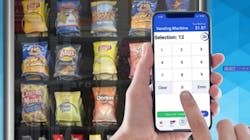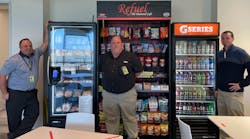Bringing touchless payment options to your vending and OCS customers
Last August, the National Retail Federation (NRF) released a report concluding that the coronavirus was leading to more consumer use of contactless credit cards and mobile payments. The report found that 67% of retailers accept some form of no-touch payment and since January of 2020, no-touch payments increased for 69% of those retailers.
As for consumers, 19% surveyed said they made a digital payment in a store for the first time in 2020. And more than half would likely continue to do so once the pandemic has subsided. While these numbers are not off the charts, they are growing.
“Health experts say there is no clear evidence that COVID-19 is transmitted by cash or credit cards, but retailers are putting health and safety first and have rolled out a variety of no-touch payment options in order to err on the side of caution,” NRF vice president for government relations, banking and financial services Leon Buck said in a press release.
“While mobile payments and contactless cards have accounted for a minority of payments in the past,” Buck continued, “the pandemic has clearly driven consumers to change their behavior and retailers to accelerate their adoption of the technology.”
The pandemic has certainly driven consumers to change their behavior. “I, personally, began ordering items via mobile app for curbside pickup and groceries for home delivery,” Buck noted. “I even contacted my bank to receive a new debit card to make touchless purchases—not just for safety reasons, but because I realized just how simple touchless purchases could be. Would I have done these things without the push of a global pandemic? Perhaps in several years, maybe.”
But as Buck noted, the pandemic has driven a change in behavior for both consumers and retailers.
For grocery retailers, specifically, ACI Worldwide, a provider of real-time digital payment software and solutions, found that 35% of consumers would be willing to leave their preferred grocers for others that allow them to pay in-store in a touchless manner.
Debbie Guerra, executive vice president, ACI Worldwide said in statement, “In the wake of the pandemic, a new type of consumer is emerging, one who shops less in-store and represents a quickly growing part of the digital-first economy. For grocery stores, this is a huge opportunity to cater to these consumers by providing digital and contactless payment options.”
Just as other retailers around the U.S are taking notice of changing consumer purchasing habits, so too must the vending and OCS industry.
In our industry
Global self-service technology leader, 365 Retail Markets, introduced its 365 Touchless Vending which allows customers to purchase vending items from their smartphone via the 365Pay app. The solution requires no connectivity set up, using a Bluetooth connection to work between your vending machine and the consumer’s phone.
Similarly, 365 Touchless Coffee allows operators to automate the in-office coffee experience by connecting directly to the machine via 365Pay.
This solution is powered by 365Beacon and BUNNlink, a cloud-based solution with a wide variety of hot beverage options.
“During the pandemic, 365 saw an incredible uptick in usage of our industry-leading 365Pay consumer app. Much of this was simply using the app to pay at a V5 MicroMarket kiosk or the new PicoCooler using the QR code in the app,” explained 365 vice president of product Ryan McWhirter.
“That said, we also saw a record number of scan/pay transactions using 365Beacon and a rise in café/dining order ahead transactions from 365Pay,” McWhirter added. “Now Touchless Vending and Touchless Coffee join that same ‘Swiss army knife for the convenience services industry’; 365Pay, where all six of these touchless transaction technologies come together in one easy place.”
These are just a few examples of how the vending industry can continue to compete for the consumer dollar.
Consumers and retailers are moving toward contactless payments and the numbers are only increasing. Gartner, a research and advisory company, predicts that by 2024, 80% of ordering and replenishment will be touchless for most organizations. The vending industry has an opportunity to provide consumers with the same touchless purchasing experience they are coming to expect at other retail operations.

Adrienne Klein | Contributing Editor
Adrienne Zimmer Klein is a freelance writer with a background in the vending, micro market and office coffee service industry. She worked as an associate editor and managing editor at Automatic Merchandiser and VendingMarketWatch.com from 2013 until 2017. She is a regular contributing writer at Automatic Merchandiser.







